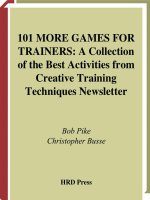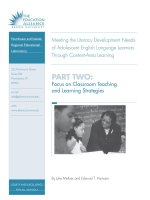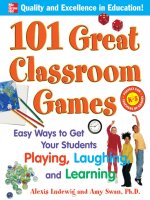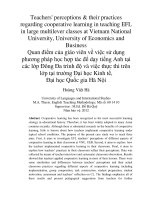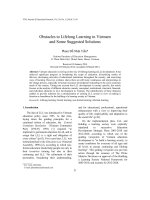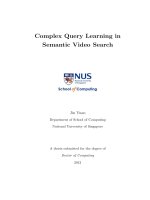101 101 classroom games energize learning in any subject (gareth long harvey grout stuart taylor)
Bạn đang xem bản rút gọn của tài liệu. Xem và tải ngay bản đầy đủ của tài liệu tại đây (13.23 MB, 146 trang )
101
Classroom
Games
Energize Learning in Any Subject
Gareth Long
Harvey Grout
Stuart Taylor
Human Kinetics
Library of Congress Cataloging-in-Publication Data
Long, Gareth, 1974101 classroom games : energize learning in any subject / Gareth Long, Harvey Grout, Stuart Taylor.
p. cm.
ISBN-13: 978-0-7360-9510-5 (soft cover)
ISBN-10: 0-7360-9510-1 (soft cover)
1. Educational games. I. Grout, Harvey. II. Taylor, Stuart, 1975- III. Title. IV. Title:
One hundred one classroom games. V. Title: One hundred and one classroom games.
LB1029.G3L66 2011
371.33'7--dc22
2010032222
ISBN-10: 0-7360-9510-1 (print)
ISBN-13: 978-0-7360-9510-5 (print)
Copyright © 2011 by Gareth Long, Harvey Grout, and Stuart Taylor
This book is copyrighted under the Berne Convention. All rights are reserved. Apart from any
fair dealing for the purposes of private study, research, criticism, or review, as permitted under
the Copyright, Designs, and Patents Act 1988, no part of this publication may be reproduced,
stored in a retrieval system, or transmitted in any form or by any means, electronic, electrical,
chemical, mechanical, optical, photocopying, recording, or otherwise, without prior written
permission of the publisher.
Notice: Permission to reproduce the following material is granted to instructors and agencies
who have purchased 101 Classroom Games: pp. 4, 8, 12, 14, 18, 20, 25, 27, 28, 29, 39, 51, 60,
62, 68, 89, 102, 103, 104, 110, 118, 125, 128, 132. The reproduction of other parts of this book is
expressly forbidden by the above copyright notice. Persons or agencies who have not purchased
101 Classroom Games may not reproduce any material.
The Web addresses cited in this text were current as of October 13, 2010, unless otherwise noted.
Acquisitions Editor: John Dickinson; Managing Editor: Bethany J. Bentley; Assistant Editor:
Derek Campbell; Copyeditor: Mary Rivers; Graphic Designer: Joe Buck; Graphic Artist: Dawn
Sills; Cover Designer: Keith Blomberg; Photographer (cover): Sharon Dominick/Photodisc; Art
Manager: Kelly Hendren; Associate Art Manager: Alan L. Wilborn; Illustrations: © Human
Kinetics; Printer: Versa Press
Printed in the United States of America 10 9 8 7 6 5 4 3 2 1
The paper in this book is certified under a sustainable forestry program.
Human Kinetics
Web site: www.HumanKinetics.com
United States: Human Kinetics
P.O. Box 5076
Champaign, IL 61825-5076
800-747-4457
e-mail:
Australia: Human Kinetics
57A Price Avenue
Lower Mitcham, South Australia 5062
08 8372 0999
e-mail:
Canada: Human Kinetics
475 Devonshire Road Unit 100
Windsor, ON N8Y 2L5
800-465-7301 (in Canada only)
e-mail:
New Zealand: Human Kinetics
P.O. Box 80
Torrens Park, South Australia 5062
0800 222 062
e-mail:
Europe: Human Kinetics
107 Bradford Road
Stanningley
Leeds LS28 6AT, United Kingdom
+44 (0) 113 255 5665
e-mail:
E5171
For Rylan and Ashton.
—Gareth Long
For Rachel and Florence.
—Harvey Grout
For Rach and family.
—Stuart Taylor
Contents
Preface viii
Games
iv
1
Ace of Spades . . . . . . . . . . . . . . . . . . . . . . 2
2
All Bases Covered . . . . . . . . . . . . . . . . . . . . 3
3
Amnesia . . . . . . . . . . . . . . . . . . . . . . . . . 5
4
Baseball . . . . . . . . . . . . . . . . . . . . . . . . . 6
5
Basketball . . . . . . . . . . . . . . . . . . . . . . . . 7
6
Beach Volleyball . . . . . . . . . . . . . . . . . . . . . 9
7
Bidding for Success . . . . . . . . . . . . . . . . . . . 11
8
Boxing Clever . . . . . . . . . . . . . . . . . . . . . . 13
9
Bull's-Eye . . . . . . . . . . . . . . . . . . . . . . . . 15
10
Chain Gangs . . . . . . . . . . . . . . . . . . . . . . 16
11
Championship Golf . . . . . . . . . . . . . . . . . . . 17
12
Connect 4 . . . . . . . . . . . . . . . . . . . . . . . 19
13
Crossfire . . . . . . . . . . . . . . . . . . . . . . . . 21
14
Definition Bingo . . . . . . . . . . . . . . . . . . . . 22
15
Domes and Dishes . . . . . . . . . . . . . . . . . . . 23
16
Faster, Higher, Stronger . . . . . . . . . . . . . . . . . 24
17
Fortune Teller . . . . . . . . . . . . . . . . . . . . . . 26
18
Four in a Row . . . . . . . . . . . . . . . . . . . . . . 30
19
Full House . . . . . . . . . . . . . . . . . . . . . . . 31
20
Good Arrows . . . . . . . . . . . . . . . . . . . . . 32
21
Great Balls of Fire! . . . . . . . . . . . . . . . . . . . 33
22
Hand Over Hand . . . . . . . . . . . . . . . . . . . 34
23
Head to Head . . . . . . . . . . . . . . . . . . . . . . 35
Contents v
24
Heads or Tails . . . . . . . . . . . . . . . . . . . . . . 36
25
Heads, Shoulders, Knees and Toes . . . . . . . . . . . 37
26
High Jump . . . . . . . . . . . . . . . . . . . . . . . 38
27
Howzat! . . . . . . . . . . . . . . . . . . . . . . . . 40
28
I Am Not . . . . . . . . . . . . . . . . . . . . . . . 41
29
It’s Just a Jump to the Left . . . . . . . . . . . . . . . 42
30
Judge and Jury . . . . . . . . . . . . . . . . . . . . . 43
31
Killer Questions . . . . . . . . . . . . . . . . . . . . . 44
32
Knockout Arguments . . . . . . . . . . . . . . . . . 45
33
Ladders . . . . . . . . . . . . . . . . . . . . . . . . . 46
34
Last Past the Finish Line . . . . . . . . . . . . . . . . . 47
35
Let’s Get Ready to Tumble . . . . . . . . . . . . . . . 48
36
Lie Detectors . . . . . . . . . . . . . . . . . . . . . 49
37
Make It, Draw It or Mime It . . . . . . . . . . . . . . . 50
38
Marbles . . . . . . . . . . . . . . . . . . . . . . . . . 52
39
Missing Links . . . . . . . . . . . . . . . . . . . . . 53
40
Number Minefield . . . . . . . . . . . . . . . . . . . 54
41
Our Survey Says... . . . . . . . . . . . . . . . . . . . 55
42
Overtake . . . . . . . . . . . . . . . . . . . . . . . 56
43
Pairs . . . . . . . . . . . . . . . . . . . . . . . . . . 57
44
Pass It On . . . . . . . . . . . . . . . . . . . . . . . . 58
45
Peek, Copy, All In or Save . . . . . . . . . . . . . . . . 59
46
Penalty Shootout . . . . . . . . . . . . . . . . . . . 61
47
Phone a Friend . . . . . . . . . . . . . . . . . . . . 63
48
Pick and Mix . . . . . . . . . . . . . . . . . . . . . . 64
49
Picture Perfect . . . . . . . . . . . . . . . . . . . . . 65
50
Pin the Tail on the... . . . . . . . . . . . . . . . . . . 66
vi Contents
51
Pool Championships . . . . . . . . . . . . . . . . . . 67
52
Post-it Note Scramble . . . . . . . . . . . . . . . . . . 69
53
Puzzled . . . . . . . . . . . . . . . . . . . . . . . . . 70
54
Question Ball . . . . . . . . . . . . . . . . . . . . . 71
55
Question Conkers . . . . . . . . . . . . . . . . . . . . 72
56
Quizzical Chairs . . . . . . . . . . . . . . . . . . . . . 73
57
Racing Cars . . . . . . . . . . . . . . . . . . . . . . . 74
58
Randomizer . . . . . . . . . . . . . . . . . . . . . . . 75
59
Red Herrings . . . . . . . . . . . . . . . . . . . . . . 76
60
Red or Black . . . . . . . . . . . . . . . . . . . . . . 77
61
Relay Runners . . . . . . . . . . . . . . . . . . . . . . 78
62
Remember My Name . . . . . . . . . . . . . . . . . . 79
63
Remember, Remember . . . . . . . . . . . . . . . . 80
64
Review Tennis . . . . . . . . . . . . . . . . . . . . . . 81
65
River Crossing . . . . . . . . . . . . . . . . . . . . . . 83
66
Rock, Paper, Scissors . . . . . . . . . . . . . . . . . . 84
67
Roll With It . . . . . . . . . . . . . . . . . . . . . . 85
68
Run Around . . . . . . . . . . . . . . . . . . . . . . . 86
69
Sabotage . . . . . . . . . . . . . . . . . . . . . . . 87
70
Show Jumping . . . . . . . . . . . . . . . . . . . . . 88
71
Snakes and Ladders . . . . . . . . . . . . . . . . . . . 90
72
Snap . . . . . . . . . . . . . . . . . . . . . . . . . . 91
73
Splat . . . . . . . . . . . . . . . . . . . . . . . . . . 92
74
Stand to Attention . . . . . . . . . . . . . . . . . . . 93
75
Stand Up and Be Counted . . . . . . . . . . . . . . . 94
76
Steal a Brain . . . . . . . . . . . . . . . . . . . . . . 95
77
Step Up to the Challenge . . . . . . . . . . . . . . . . 96
Contents vii
78
Stop the Clock . . . . . . . . . . . . . . . . . . . . . 98
79
Straws . . . . . . . . . . . . . . . . . . . . . . . . . 99
80
Strike a Deal . . . . . . . . . . . . . . . . . . . . .
100
81
Super Bowl . . . . . . . . . . . . . . . . . . . . .
105
82
Surf’s Up . . . . . . . . . . . . . . . . . . . . . . . 107
83
Tenpin Bowling . . . . . . . . . . . . . . . . . . . . 109
84
The Hat . . . . . . . . . . . . . . . . . . . . . . . . 111
85
The Picture Board . . . . . . . . . . . . . . . . . . . 112
86
Time Assault . . . . . . . . . . . . . . . . . . . . . . 113
87
Time Bombs . . . . . . . . . . . . . . . . . . . . . . 114
88
Topic Lotto . . . . . . . . . . . . . . . . . . . . . . 115
89
Traffic Lights . . . . . . . . . . . . . . . . . . . . . 116
90
True or False? . . . . . . . . . . . . . . . . . . . . . 117
91
Walkabout . . . . . . . . . . . . . . . . . . . . . . . 119
92
What’s the Question? . . . . . . . . . . . . . . . . . 120
93
Which Way Is Best? . . . . . . . . . . . . . . . . .
121
94
Who Am I? . . . . . . . . . . . . . . . . . . . . .
123
95
Who Wants to Be a Smartie? . . . . . . . . . . . . . 124
96
Winner . . . . . . . . . . . . . . . . . . . . . . . . 126
97
Wise Words . . . . . . . . . . . . . . . . . . . . . . 127
98
Withdrawal . . . . . . . . . . . . . . . . . . . . . . 129
99
Whiteboard Wonders . . . . . . . . . . . . . . . . . 130
100
Word Grids . . . . . . . . . . . . . . . . . . . . .
101
Word Rebounds . . . . . . . . . . . . . . . . . . . . 133
About the Authors 135
131
Preface
W
e’ll try not to keep you reading this too long since the
best part of this book is the games. However, before you
try them out, we will briefly explain why we believe that
interactive games can be a great strategy for enhancing motivation
and learning within the classroom, and why this should be a book
that you keep in your classroom, ready to use!
Although they have many benefits, the best is their use in the
classroom to help your pupils review what they already know about
a subject or topic; games can help them relate the topic to enjoyable
learning experiences and important study skills; and finally, games
can be used prior to formal and informal assessments. Traditionally,
teachers have too often provided pupils with information, and then
assessed whether it has been remembered through a show of hands
or tests and exams. We feel that games offer an additional way of
contributing to a stimulating learning environment and provide an
additional method for assessing learning. In short, we feel that the use
of games can make learning more memorable, fun, and successful.
Interactive games are those in which there may be interaction with
the environment, interaction with other pupils, interaction with tasks
and problems, and of course, interaction with the teacher. If there can
also be movement, music, and friendly competition, it’s even better!
The games in this book can be used in a variety of ways. They are
designed to be used as an effective starter activity, for the middle part
of a lesson to reignite learning at a time when pupils may potentially
switch off, or as a final plenary activity to assess pupil learning. Furthermore, they may be recommended to pupils and parents for learning
outside the school environment. The games are arranged alphabetically, but we’ve included the key benefits at the top of each game so
that you can see them at a glance while flipping through the book.
We hope that you like the 101 interactive classroom games outlined
in this book; we hope even more that you play them with your class;
and most of all, we hope that you adapt and improve them! All we
ask is that if you do make changes, please let us know by contacting
us at
viii
1
GAMES
1
Ace of Spades
Promote discussion about possible answers.
Work in groups.
Equipment
■■ A
pack of cards
■■ A
set of questions
Description
A pack of cards (with numbers 2 to 10) is spread out face down on
a table at the back of the class, and the pupils stand at the front of
the class.
The teacher reads a question (or it is projected onto the whiteboard), and without any talking, the pupils move to the cards; each
turns over one card. The pupils then move to the table that corresponds with their number card (for instance, all pupils who turn
over a four meet at table four).
The pupils discuss the question with their teammates, and after
a set period of time, provide an answer. If the answer is correct, all
team members get 10 points. The class then returns the cards to
the original table and returns to the front of the class for the next
question. Pupils will form a new team for each question. Pupils keep
their own scores to see how many points they get by the end of
the lesson.
Variations
Easier: Put the ace of spades in the pack. If a pupil picks that
card, she can join a table of her choice, and if that table gets
the question right, each pupil scores double points.
Harder: Have an uneven number of cards on the table (for
instance, only two 5s). Therefore, some teams will have fewer
pupils than others to discuss the answer.
2
2
All Bases Covered
Learn key concepts and definitions.
Practice multiple-choice questions and answers.
Equipment
■■ One
■■ 10
A B C D card for each pupil (see page 4)
markers per pupil (counters or poker chips work well)
■■ Prepared
multiple-choice questions
Description
This game is based on the TV game show Dual. Provide each pupil
with a card that has an A, B, C and D on it. Each pupil will also need
10 markers.
Read or display a multiple-choice question, and have each pupil
choose the correct answer by covering it with a marker. Reveal the
right answer, and instruct the pupils that they may keep any marker
covering a correct answer; any markers that are placed on incorrect
answers are returned to the teacher. A pupil is out of the game if he
fails to cover the correct answer with a marker (he may then join a
classmate).
If the pupil is convinced he knows the answer, he will only use
one marker (on the correct answer) and therefore will still have 10
markers at the end of the question. If he has no idea of the answer,
he may use a marker on each answer (this way he will stay in the
game but lose 3 markers).
You might play until only one pupil is left or to a set period of time
and see which pupil has the most markers remaining.
Variations
Easier: Allow the pupils one lifeline that allows them to get out of
their seats and look at their classmates’ answers.
Harder: Give pupils a different number of markers when starting
the game.
3
4
From G. Long, H. Grout, and S. Taylor, 2011, 101 Classroom Games (Champaign, IL: Human Kinetics).
A B CD
Cards for All Bases Covered
3
Amnesia
Learn how to ask questions.
Practice recall and interpretation.
Equipment
■■ Post-it
notes
■■ Pens
Description
Place your pupils in groups of five or six and have them sit in a circle
facing each other. Give the pupils a category from the subject area
being studied and ask them to write down a concept or keyword on
a Post-it without anyone else seeing it. Pupils place the completed
Post-it on the forehead of the person to their left.
Taking it in turns, each pupil is allowed to ask a question of each of
the other players within the circle in order to find out what is written
on their own note. The other players can only answer yes or no to
the questions. Pupils should keep track of the number of questions
they must ask before they can determine the content of the Post-it.
The pupil who asks the fewest questions wins.
Variations
Easier: Make the subject areas simple to guess by limiting the
number of keywords available.
Harder: Place a time limit on the question period for each pupil.
5
4
Baseball
Learn key concepts.
Practice answering questions under pressure.
Provide more than one answer.
Equipment
A set of questions
Description
Pupils play this game in teams of three. Half of the teams consist of
a pitcher and two fielders. The other half each has three batters. The
batting teams play against the pitching teams.
To play, the first pupil on the batting team steps up to the plate.
The pitcher on the opposing team fires a question (which must have
at least 4 possible answers) at the batsman who has 20 seconds to
answer. If she gives one correct answer, she moves to first base; two
correct answers get her to second base; three correct answers move
her to third base; and four correct answers are a home run.
However, if the batsman doesn’t provide all four answers, then
the two fielders have the opportunity to answer. If they can provide
one more correct answer to the question, then the batsman is out.
Each incorrect answer (including no answer) is a strike. Three strikes
and the batsman is out.
Once the batters’ team is all out, the fielding team goes to bat.
The team that scores the most runs wins.
Variations
Easier: Play in larger teams or allow the team of three to collaborate on an answer.
Harder: Allow only 10-15 seconds for pupils to answer.
6
5
Basketball
Learn key concepts and definitions.
Use textbooks to locate answers.
Equipment
■■ Basketball
board (see page 8)
■■ Die
■■ A
set of questions
Description
The aim of the game is to score as many points as possible. Pupils
play against each other in groups or pairs. The first player rolls the
die and moves the number of squares shown on the die. What the
pupil does next depends on the square he lands on.
Question
Pass
Dribble
Foul
Shoot
Layup
He answers a question.
He answers a question, but he is able to use his textbook.
He rolls the dice again.
His turn is over, and the next pupil rolls the die.
If he answers the question correctly, he scores a
3-point basket and starts back at the beginning.
If he answers the question correctly, he scores a
2-point basket and starts back at the beginning.
If a pupil answers a question incorrectly, or if he lands on a foul
square, his turn is over and it is the next pupil’s turn. The aim is to
score as many points as possible in the time the match is taking place.
Variations
Easier: Add more pass squares to the board or work in pairs.
Harder: Before the game begins, the pupils design their own
questions, with answers, to ask their partners.
7
Basketball Board
START
1 QUESTION
2 PASS
3 QUESTION
4 QUESTION
5 DRIBBLE
6 QUESTION
7 QUESTION
8 DRIBBLE
9 FOUL
10 QUESTION
11 PASS
12 QUESTION
13 QUESTION
14 SHOOT
15 FOUL
16 DRIBBLE
17 QUESTION
18 PASS
19 SHOOT
20 FOUL
21 SHOOT
22 QUESTION
23 FOUL
24 PASS
25 QUESTION
26 DRIBBLE
27 QUESTION
28 QUESTION
29 SHOOT
30 QUESTION
31 SHOOT
32 QUESTION
33 FOUL
34 QUESTION
35 QUESTION
36 SHOOT
37 FOUL
38 LAYUP SHOT
39 QUESTION
40 QUESTION
41 SHOOT
42 SHOOT
43 QUESTION
44 QUESTION
45 LAYUP SHOT
46 FOUL
BASKET
SCORED
From G. Long, H. Grout, and S. Taylor, 2011, 101 Classroom Games (Champaign, IL:
Human Kinetics).
8
6
Beach Volleyball
Assess knowledge and understanding.
Prepare for examinations.
Use textbooks to locate information.
Equipment
■■ A
set of serve cards (see following examples)
■■ A
textbook
Description
The teacher or pupils prepare a series of serve cards that have questions worth three marks (such as the ones that follow).
Name three muscles
in the upper body.
Name three parts
of the circulatory
system.
The class is put in teams of two, and one team plays against
another (as in beach volleyball). Team A serves and turns over a card
for team B to receive.
9
To score a point, team B has to provide three answers to a question.
If they can’t provide three answers, then the point goes to team A.
In volleyball a player cannot touch the ball twice, so in this game, a
team member cannot provide two answers in a row. Both members
of the team have to contribute to win a point. Team B then serves
and turns over a card for team A. A textbook acts as the referee!
Variations
Easier: Allow the teams a set number of time-outs. When a team
decides to use a time-out, they have 45 seconds to find the
answer in their books.
Harder: Introduce a set number of blocks that each team can play.
In this variation, if team A get three correct answers to a question, team B can play a block, meaning team A has to provide
one more example to get the point.
10
7
Bidding for Success
Learn key concepts.
Learn facts.
Equipment
Fake money
Description
The goal of this game is to win as many correct statements as possible.
Each player/team starts with £100. Begin by reading a statement,
which may or may not be true (this will work best if the statements
are not easy). Once a statement is read, all players or teams submit
a secret bid on paper labeled with their names (see page 12) and
hand it to the teacher (like on eBay). If the player or team believes
the statement is false, they will put a bid of £0. If they believe it
is correct, they will bid a price and hope that they get to buy the
statement, whilst not spending all their money. The team with the
highest bid wins the statement.
When all statements have been bought, the teacher will indicate
whether the statements were true or false. The player or team with
the most correct statements is the winner. In the case of a draw, the
team who has the most money left is the winner.
Sample Statements
‘The pulmonary artery takes blood from the heart to the lungs.’
Since this is a true statement, hopefully everyone will bid more
than £0. The highest bidder wins the statement and subtracts
the money paid from her total.
‘The hamstring is made up of four muscles.’ Since this is a false
statement, hopefully everyone will bid £0. If so, the statement
is not purchased. If money is bid, then the highest bidder wins
the statement but will find out at the end of the game that her
money was wasted!
Variations
Easier: Allow pupils to use a textbook or the Internet for a set
time for each question.
Harder: Pupils or teams go bankrupt if they buy a false statement.
11
Bidding for Success Bids
Name: ____________________________________________________
We would like to bid the following amount of money ____________
For statement number_____________________
Name: ____________________________________________________
We would like to bid the following amount of money ___________
For statement number_____________________
Name: ____________________________________________________
We would like to bid the following amount of money ____________
For statement number_____________________
Name: _____________________________________________________
We would like to bid the following amount of money ____________
For statement number_____________________
Name: ____________________________________________________
We would like to bid the following amount of money ____________
For statement number_____________________
Name: ____________________________________________________
We would like to bid the following amount of money ____________
For statement number_____________________
From G. Long, H. Grout, and S. Taylor, 2011, 101 Classroom Games (Champaign, IL:
Human Kinetics).
12
8
Boxing Clever
Learn key concepts and definitions.
Equipment
■■ A
set of boxing cards (see page 14)
■■ A
set of definition cards
■■ A
stopwatch
Description
Pair up the class (so pupil A gets ready to box pupil B). The boxing
cards (see page 14) are shuffled and placed in the middle of the pair.
Both pupils have a series of definition cards (see the sample definition
card; a glossary is a great source for making the definition cards).
Pupil A reads the definition on her first card (see sample). If pupil
B guesses what is being described, she gets to turn over one of the
boxing cards (see page 14). If she turns over a jab card, she gets
1 point; if she turns over a hook card, she gets 2 points; and if she
turns over an uppercut card, she gets 3 points.
If a pupil answers incorrectly or takes over 10
Definition: Injecting blood that
seconds to provide an
has been removed from the
answer, it is pupil A’s turn
body a few days earlier, enabling to answer. Each round
the blood to carry more oxygen.
lasts three minutes, and
It is banned because it’s a form
the pupil with the most
of cheating. It can cause kidney
points wins the bout. After
and heart failure.
the three minutes are up,
Word: Blood doping
the pupils move on to box
another classmate.
Variations
Easier: Allow pupils two attempts at each card or allow them a
certain number of blocks that allow them to pass.
Harder: Ask pupils to provide the definition to the word. If the
pupil gets the definition word perfect, she scores a knockout
and wins straight away.
13
Boxing Clever Cards
Jab
1 Point
Hook Uppercut
2 Points 3 Points
Jab
1 Point
Hook Uppercut
2 Points 3 Points
Jab
1 Point
Hook Uppercut
2 Points 3 Points
Jab
1 Point
Hook Uppercut
2 Points 3 Points
Jab
1 Point
Hook Uppercut
2 Points 3 Points
From G. Long, H. Grout, and S. Taylor, 2011, 101 Classroom Games (Champaign, IL:
Human Kinetics).
14
9
Bull’s-Eye
Learn key concepts and definitions.
Equipment
■■ 20
PowerPoint slides (or something similar) of questions
■■ A
dartboard
■■ 1
dart
Description
Prepare 20 slides or cards with one question on each (you might
decide to have a bull’s-eye slide as well). Slide 1 has the hardest
question whilst slide 20 has the easiest. Split the class into two teams.
One member of the first team throws a dart at a dart board
(Velcro darts are good for this game), and the team has to answer
the question on the slide that corresponds to the number hit by the
dart. Award a set number of points for a correct answer, and then
the other team throws a dart. Continue until there are no questions
left to answer. The team with the highest marks wins.
Variations
Easier: Have three questions on each slide, and allow the pupils
to select the one they answer.
Harder: Have a more difficult question on each slide that is worth
double points.
15
10
Chain Gangs
Prepare essay arguments or long-answer exam questions.
Share good ideas.
Equipment
■■ A
set of exam questions or essay titles
■■ A
watch, a clock, or an egg timer
Description
The goal of this game is for each team to score as many points as
they can. The team scores 1 point for every good thing they say!
(Points are awarded by the teacher.)
The teams line up like a chain, and the teacher asks an open question such as ‘Why is exercise important for a healthy lifestyle?’ and
starts the clock (for instance, for one minute).
The first pupil in the chain begins to answer the question, trying
to score as many points as possible. When he runs out of things to
say, he passes, and the next pupil in the line takes over.
You should have one sound to use to indicate something good or
accurate has been said (such as striking a percussion triangle), and
another sound that indicates something not very good (for instance,
blowing a party noisemaker). After the time is up, the next chain gang
steps forward for their question and tries to get the highest score.
Variations
Easier: Allow the pupils to decide on the order of their chain.
Harder: Add the rule that all the members of the chain must have
scored at least 1 point before the time runs out (in other words,
everyone must speak); otherwise the team scores 0!
16
